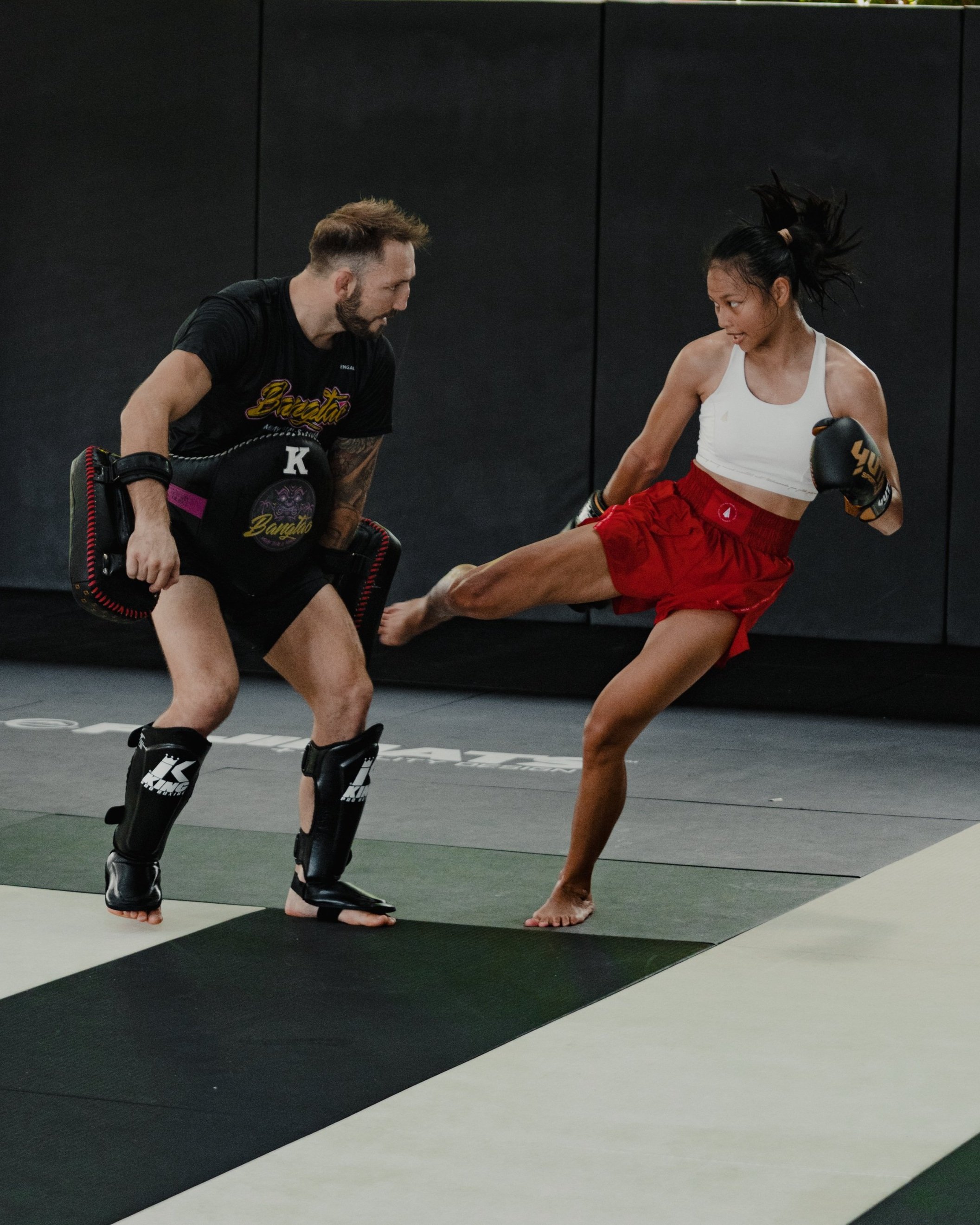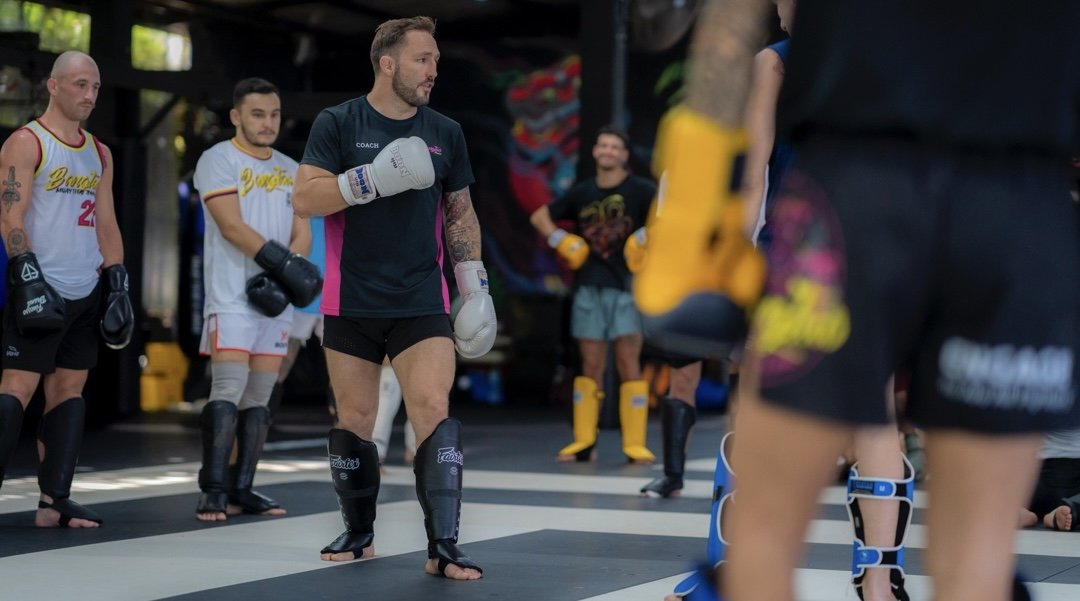Become 100% confident in your ability to fight taller opponents.
The Ultimate Short Fighter’s Guide is a comprehensive striking course comprised of techniques I’ve used against taller fighters at the highest level in the world. After this course, you’ll be able to go from being lost to being able to successfully set up and land shots, all while staying defensively sound.
“I know how to set up combinations, but I have trouble closing the initial distance without eating a bunch of jabs and low kicks.”
If this sounds like you, just know that developing good distance management takes time, but even seasoned fighters struggle when it comes to dealing with long limbs in their face.
After teaching a number of seminars, I’ve noticed most people seem to have the same problem:
They feel confident landing when in range. However, hitting without getting hit becomes problematic when they run into the scenario of I can’t reach them, but they can reach me.
In other words, these fighters:
Have a solid knowledge base
Are technically sound
But have difficulty dictating the range
When it comes to dealing with taller opponents, most fighters can’t solve the distance problem and resort to:
(1) waiting for their opponent to punch and hoping an opportunity to counter surfaces, only to end up as a sitting duck and outpointed.
or
(2) putting up a cage guard, moving forward, and taking a bunch of heat.
And as someone who spent the earlier part of my career doing the latter, I wish I had known and implemented what I know now much sooner.
I realized I needed a systematic approach to fighting a taller person:
-
We need to be able to get in range fast.
-
The problem with fighting a tall person is that it’s much easier for them to reach you, but it’s much harder for you to reach them. That means if you don't offer any deterrence they can simply walk forward and continuously back you up. You must attack them at some point, but if you just step in and attack, they can easily see you moving in. They can intercept, or they can just step back out of range again.
You have to vary your entries to keep them guessing and make it hard for them to know what you're going to attack them with and when you will attack them.
But once you have all those different entries, you have to make them guess when you're going to come in, so you have to fake.
-
Your fakes can't just be a normal lead leg fake because there’s too much distance to cover after the fake. That fake doesn't really sell the fact that you’re going to attack because you’re still too far away. The solution is to change your fake.
I will show you how in this course.
Once you’ve attacked your opponent, if you step back out they can just step forward and hit you with their long limbs.
That means you need to exit to the sides.
-
If we exit to the sides too often, it becomes predictable.
Consequently, you have to start exiting going backwards again.
Remember that problem of getting hit when you went straight backward? Well, you need a way to exit straight back out that disrupts their counter attack.
Hint: there is an entire section on exits in the course as well.
-
Assuming you’ve done all of the above, you still haven't even started to move laterally. Otherwise, you’re still standing in front of the person. You need to add lateral movement into the mix.
However, when you move to the power (open) side, your footwork will be slightly different in order to stay on the edge of range.
When I move this way I need to be able to answer 2 questions:
(1) Can I attack?
(2) Can I defend?
In this course, I will show you how to answer “yes” to both of these questions.
-
If you attack with your head still directly on the punching line, they can stop your entry with just one punch on the way in.
Even if you fake and use different entries, they can just stick a jab out or stop you on the way in.
Hence, you need to add head movement with your entries. Every entry you perform must allow you to move your head then attack.
If you get them moving backwards, you must make sure your feet are underneath you, so you can continuously attack them and make the most of the opportunity of getting on the inside against somebody taller.
If you are lost as to how the 6 points above fit together into one system for dealing with taller opponents…
Hi, I’m Brad Riddell
I’ve dedicated the past 17 years being a student of the fight game and have spent most of my career fighting taller people.
I’m currently a Light Weight in the UFC. I’ve trained with and coached some of the highest level mixed martial artists in the world.
The system I will teach you will give you the tools to be able to compete against taller opponents in combat sports with confidence.




Why I Created This Course
I always found it fun fighting and sparring taller people. Maybe that’s because of the fact that I trained with so many high level tall people, so often. They were constantly adapting to me, which forced me to constantly evolve and expand my tool box for them.
By far, the most frequently asked question I receive is, “How do I deal with a taller opponent?” When people would ask me about fighting taller opponents, they were frustrated and didn’t seem to enjoy it as much as I did. That’s when I realised that some people don’t have tall people to train with and troubleshoot regularly like I do. They can’t come back to the next session to make adjustments. And then they get matched with a tall person. It can be daunting because it’s hard to know what to do against the unknown.
Most instructional videos or tutorials I’ve come across approach martial arts as a topic:
(1) show various applications of a specific technique
(2) highlight problems you may encounter when using this technique
(3) and then address effective counters to deal with these problems
THIS IS NOT WRONG!
However, I wanted to make a course that solves a very specific problem, give you MULTIPLE techniques to solve this problem of tall people, AND give you the underlying principles of WHY so that you can eventually create your own solutions in addition to the ones that you learn here in this course.

